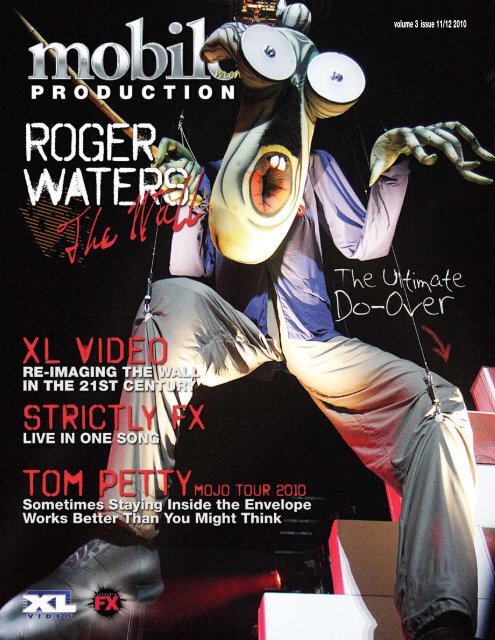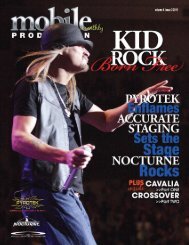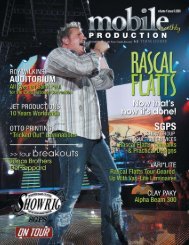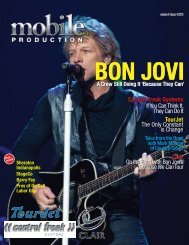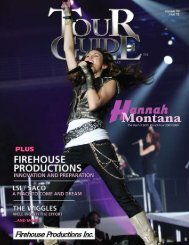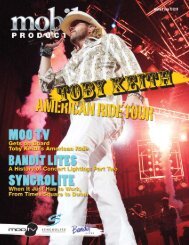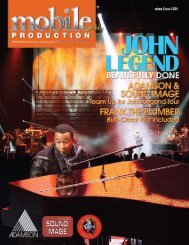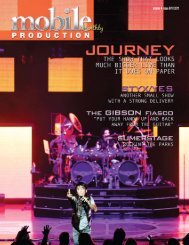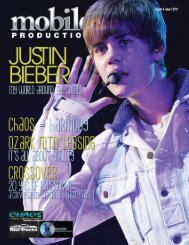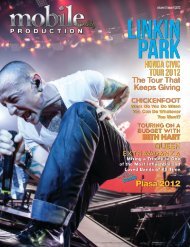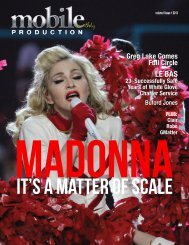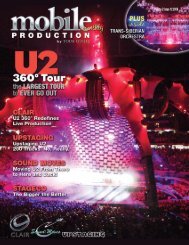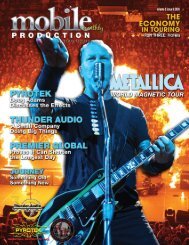volume 3 issue 11/12 2010 - Mobile Production Pro
volume 3 issue 11/12 2010 - Mobile Production Pro
volume 3 issue 11/12 2010 - Mobile Production Pro
- No tags were found...
Create successful ePaper yourself
Turn your PDF publications into a flip-book with our unique Google optimized e-Paper software.
<strong>volume</strong> 3 <strong>issue</strong> <strong>11</strong>/<strong>12</strong> <strong>2010</strong>
*Sentient Charter is a program of Sentient Jet, LLC (“Sentient”). Sentient arranges flights on behalf of clients with FAR Part 135 air carriers that exercise full operational control of charter flights at all times. Flights will be operated byFAR Part 135 air carriers that have been certified to provide service for Sentient and that meet all FAA safety standards and additional safety standards established by Sentient. (Refer to www.sentient.com/standards for details.)Your Access toPerformance with Passion.At Sentient * , we understand that success isn’t something that comes easily. Ittakes focus, years of preparation and relentless dedication. With an innovative9-point safety program and a staff of service professionals available 24/7, it’s nowonder that Sentient is the #1 arranger of charter flights in the country. SentientCharter can take you anywhere on the world’s stage - on the jet you want - at thecompetitive price you deserve.Sentient Jet is the <strong>Pro</strong>ud Platinum Sponsor ofthe TourLink <strong>2010</strong> Conference Jet BarbequeTO LEARN MORE, PLEASE CONTACT:David Young, Vice President - Entertainment, at dyoung@sentient.com or 805.899.4747
contents<strong>volume</strong> 3 <strong>issue</strong> <strong>11</strong>/<strong>12</strong> <strong>2010</strong>photo courtesy of Mark Fisher8<strong>12</strong>16mobileproductionmonthly246 SoundA Tale of Ribbons on the RoadAre ribbon mics up to the rigors of touring?Yes, according to Maroon 5’s Jim Ebdon.8 Gabriel Sound Lord of the Rack Realms10 LightingHSL Supplies Total Lights for Foals UK & European tour<strong>12</strong> StagingKinesys For Stage Design, Israel16 Tour Breakout - Tom Petty <strong>2010</strong>Tom Petty Sometimes Staying Inside the Envelope Works Better ThanYou Might Think20 Tour Personnel24 Roger Waters The WallThe Ultimate Do-Over30 Tour Personnel31 Tour Vendors32 XL VideoRe-Imaging The Wall in the 21st Century34 Strictly FXLive In One Song38 Advertiser's Indexmobile production monthly 3
FROM THE PublisherAs we wrap up the year, we have put <strong>issue</strong> <strong>11</strong> & <strong>12</strong>together for the first time. Honestly, this year has beenhectic and with staff changes and the explosion ofinterest in Tour Link, we simply fell behind and this is the onlyway we could get back on schedule. Our cover feature, RogerWaters is combined with our coverage of the recent Tom Pettytour. We hope you will enjoy the reading.As I mentioned, Tour Link has experienced a dramatic increasein attendance and interest from all parts of the industry. Thenew Entertainer Motorcoach Council has decided to hold oneof its annual meetings with us. Manufacturers are inquiringabout hosting workshops and registrations are pouring infrom the UK, Austria, Germany, Japan and Canada. Thecurrent list reads like a virtual “Who’s Who” of the industry,and it is gratifying to see that people are coming for the entireevent, not just the Saturday evening Award Show. See a list attourlinkconference.comFinally as we close out our business year, I want to send outa special message to the Regional <strong><strong>Pro</strong>duction</strong> Companies,the touring personnel and anyone else who has the idea thatTour Link is just for the “Big Guys”. This event is designedto accommodate everyone from entry level to the seasonedprofessional, from major to new companies, riggers toCEOs. This is truly a wide open event. I can tell you fromnearly 30 years of experience attending similar events andthis one in particular, that the relationships that are formedand the information that is gained will make a difference inyour professional and personal lives. For me, it made all thedifference. Please join us in Scottsdale January 27 - 29 and beprepared for a wonderful experience.Larry SmithHOME OFFICE STAFFa 7 s 3 p 2ph: 615.256.7006 • f: 615.256.70042961 Armory Dr • Nashville, TN • USA 37204mobileproductionpro.comFor advertising inquiries:ads@mobileproductionpro.comPublisher: Larry Smithlarrysmith@tourguidemag.comManaging Director: Chris Cogswellccogswell@mobileproductionpro.comChief Writer / Photographer: Michael A. Beckgrockit@comcast.netTour Link Coord.: Jen McMahanjmcmahan@mobileproductionpro.comArt Director / Graphic Designer: Kristin Salawaykristin.tourguide@gmail.comksalaway@mobileproductionpro.comOffice Manager: Jennifer Russellofficemanager@mobileproductionpro.comWebmaster: Michael Stalcupmstalcup@mobileproductionpro.comContributing Writer: Mike Whartonmikew1955@bellsouth.netTOUR LINK BOARD OF ADVISORSBenny Collins, Jim Digby, Jon Nevins, Stuart Ross,Bobby Schneider, Jay Sendyk, Seth Sheck, Nick GoldNicki Goldstein, Chuck Randall, Michelle Freedmantourlinkconference.comPUBLISHED BYAnvil <strong><strong>Pro</strong>duction</strong>s, LLCph: 615.256.7006 • f: 615.256.7004FOLLOW USfacebook.com/tourlinkconference | facebook.com/tourguidepublicationstwitter.com/mobileprodpro | twitter.com/tourlinkconf©<strong>2010</strong> Anvil <strong><strong>Pro</strong>duction</strong>s, LLC. Nothing may be reproduced without writtenpermission of the publisher. The publisher reserves the right to edit any andall editorial content included in this publication. The publisher has made everyattempt to insure accuracy and consistency of this publication. However,some listings & information may be incomplete due to a lack of informationprovided by various companies listed. Please send any inquiries to theattention of the publisher. All advertising appears at the paid solicitation ofthe advertiser. Anvil <strong><strong>Pro</strong>duction</strong>s, LLC, can not be held liable for any errors,omissions or inaccuracies appearing in this journal in the form of editorials,listings or advertising.Member of:4 mobile production monthly
Los Angeles Convention Center, LA, USAApriL <strong>12</strong>, 13, 14, 20<strong>11</strong>The major live events productionindustry under one roof.Showcasing the latest technology and expertise in the production ofmusic events, sporting events, major corporate product launches,public celebrations and much more...Exhibition space is strictly limited!Contact us now to secure your position at the showwww.eventlive-expo.cominfo@eventlive-expo.com
preamps on our DiGiCo SD7 Live DigitalConsole, he explained. “I thought about usinga separate mic pre, but I decided that wouldjust be adding electronics unnecessarily, so Ijust go straight into the board. What’s particularlynice about the SD7 is its tube emulator,which I use quite a bit. The emulator adds abit of warmth and crunch that I might nototherwise have.”So are ribbon mics—a stalwart of high-endrecording studios everywhere—too much troubleto be used successfully on tour? “That’san old wives’ tale,” says Ebdon. “We had twoR-<strong>12</strong>1’s that have gone around the world on aprevious tour and, I’m telling you, these micswere well used. They’ve been on airplanesand were routinely exposed to pressure andtemperature changes for a good year or so. Isent them to Royer Labs to have them checkedout—to make certain they were up to snuff forthe next project. Royer’s technicians inspectedthem and found absolutely nothing to repairor adjust. Everything was up to spec.”As for handling, Ebdon reports their ribbonmics are handled carefully, but do not receiveany special attention that their other equipmentdoesn’t receive. “We have a personwhose job is to look after the mics, and so healways makes certain that they are properlyprotected,” Ebdon explained. “While I’m surethey get their fare share of bumps and knocks,and we’ve also exposed them to some prettydrastic temperature variations, they don’t getany special treatment other than the fact that Ilisten every day to the mics. Handled responsibly,they’re fine.”Ebdon was quick to point out that the RoyerR-<strong>12</strong>1 Live and R-101 mics have reallyassumed an integral role with both guitarists,“When we tour, the ribbons are always on theguitar cabs,” he says. “With radio and TVappearances, this isn’t always the case. Wealways try to use our equipment on everything,but sometimes the broadcast engineers havetheir own ideas and, maybe, we’ll have toforego the ribbon mics. On the few times thishas happened, both James and Adam havenoticed—the ribbon mics have become thatimportant to their sound.”“So do I have a favorite?” asks Ebdon. “Isuppose I still prefer the R-<strong>12</strong>1 Live, if forno other reason than the fact that I’ve beenworking with them longer. But I have to tellyou, if there is a difference in the sound whenI use the R-101, it’s absolutely negligible. I’mhonestly not sure if I’d know the difference ina blindfold test. To me, that speaks <strong>volume</strong>sabout Royer’s new entry level ribbon mic. Thebuild quality and performance of these ribbonmics should never become an <strong>issue</strong> for anytouring sound professional. I’d say, ‘Auditionthem and make your own decision.’ If the micsounds right for the job, you certainly needn’thave any reservations about taking Royers outon the road.” )royerlabs.commobile production monthly 7
SoundGabriel SoundLord of the Rack RealmsBy Hank BordowitzErik Wayne & Todd Whitford of Gabriel SoundErik Wayne adjusts some screws in one of the houseracks Gabriel Sound uses to showcase some of theaudio equipment it sells. “We had to move repairsout here for a while,” he says, indicating the showroom,as he puts the tool down on a speaker cabinet. “It’scrazy. We have so much stuff going on that we had toclean up the showroom and move stuff back into therepair area. We’re not supposed to be working in here.”Repairs make up a good portion of GabrielSound’s day to day work. Located in anindustrial area of Pompton Lakes, NewJersey, about 30 miles northwest of NewYork City, the shop is unassuming. Theshowroom has several racks with a variety ofsignal processors that Gabriel sells, a coupleof portable racks, some used for its own livesound business, some recently deposited forrepair, and one or two that it rents out.“The business is divided into three parts,”Wayne, who lists his role in the business as‘Lord of the Realm,’ says. “One part is fixinggear and building stuff from scratch, thekind of stuff nobody else can do. Then, wehave the sound systems that we take out live.We also sell and do installs. The parts fluctuatewith the economy. Some years there’s anincredible amount of live work. Lately, notso much.”The showroom features large mixing boards,testifying to its live work. One sits on top ofsome showcases off to the side of the shop,while another dominates the area just to theright of the front door. The former is a digitalboard, the latter board is by Orion, andunless you recognize a quality board, you’dlikely not know it from the brand name. “It’sa real good analog board, made in Holland,”Wayne says. “I’ve only seen one other, ever.”Yet another, much smaller board is built intothe top of a road case on the display floor.“We used this for an internet TV show wedid with the New York Giants,” Wayne says.“Those TV guys, they have no concept ofaudio. If they get anything on the video tape,that’s good enough. Anything! They reallydon’t care. We told them we can make itsound good, but you’ve got to have that.”“The show was called Giants online,” addsWayne’s associate, Todd Whitford. “This guywore a Giants helmet, and he had a vocoderso he sounded like Darth Vader when heanswered questions. So we recorded stufffor them with this rack,” Wayne continues.“Once we got the TV guys not runningsound, the editing was like one take for usinstead of 22.”All the portable racks have no loose wiresvisible, and the back is sealed tight. This isa hallmark of Gabriel’s work. “We custombuild racks,” Whitford explains. “Turnkeysituations. Multi-pinned, engraved panelswith all Middle Atlantic Audio parts. Weshared a building with Bob Schulter, theowner (of Middle Atlantic), many years ago.He now rules the world as far as rack gearand racks.”“There are so many wires in here,” saysWhitford as he points to the small rack, “andif someone sets it up in a rush, if you’re at agig in the dark, you can pull a wire out, andthen it doesn’t work. People come in herewith racks, and all the wires are hanging out.So we hook it up right and seal off the back.Idiot-proof it.”“We do that with our own racks, too,”Wayne adds. “That way it always works.That’s how I get a lot of the live work,because I know the system, and I can guaranteeit’s not going to fail. I’ve never had ashow not go on.”But the most notable part of the business,the element that really sets Gabriel Soundapart, is speaker reconing. Gabriel hasbeen an authorized speaker reconing shopfor decades. “A new speaker costs $500,”Whitford explains the benefits of repairingrather than replacing. “I can recone it for$200. It is usually about half the price of anew speaker and faster.”“Also, we keep parts on hand,” Wayneadds. “How long is it going to take to get aspeaker? Usually, we can get parts fast, butright now a lot of the companies are havinga hard time, so that’s a problem.”“I just got this cone from Nevada,” saysWhitford as he points to a blown speaker onthe workbench, “and then I had a guy callme from Texas. He sent me two more ofthese. Now, he was able to get me the kits,but I have the glues and the experience. Itprobably cost more in shipping back andforth than we’re charging him for labor. Thiswill be an authorized service, an authorizedrecone, using the right stuff for it.” (See reconingsidebar)Working on speakers can be an adventure.Not so much for the reconing, but for whatis found on the way to the cone. “We finda lot of animals in old cabinets,” Waynelaughs. “You get mice and moles and beesnests. This guy did a kid’s gig at one of thelocal Jewish Schools, and he brings his PAin because there’s this weird flapping soundcoming out of it. We check out the amp andthere’s nothing wrong. We check out thespeakers, they were perfect. We put themback in the cabinet and you hear flap, flap,flap, flap, flap. So we look in the port, andthere’s this thing flapping around. We reachin and pull out this lovely metallic blue andwhite yarmulke that a kid stuck in the port.”“Another time we get this speaker and there’ssomething stuck in the port,” Wayne continues.“We begin pulling it out a little bit andsome more. And we pull, and we get thissleeve hanging out of the port. We pulledsome more, and it was a small kid’s parkathat someone had stuffed into the port somehow.”He considers this for a second. “I hopehe didn’t do it for acoustic reasons.”If ever a speaker does need that kind ofdampening for acoustic reasons, however, theGabriel team stands ready to fix it. v8 mobile production monthly
LightingHSL Supplies Total Lights forFoals UK & European tourLeading UK lighting rental company HSL is supplyinglighting kit and crew for the Foals acclaimed “TotalLife Forever” tour - as Oxford’s current finest punkyindie rockers take to the road in the UK and Europe.Lighting designer Davy Sherwin has puttogether a stunning show based around aninventive design that makes the rig appearvastly bigger than it actually is. He first met theband when they were supporting Snow Patrol,for whom he has worked for several years producingsome amazing shows, and they wanteda similar vibe, and something that suited theirenergy and ballsy music.The project is being handled by Mike Oatesfor HSL, who says, “It’s always great workingwith Davy, he is one of the most talented ofthe UK’s current new wave of LDs”.The band gave Sherwin a few basic pointersin terms of what they wanted incorporated inthe show, and then left him to it. They are verydynamic to light, with the music veering frommoody and dark to percussive and shouty tofull sensory absorbing rock out!They particularly wanted multiple shades ofblue, so the show errs towards the colder endof the spectrum in terms of colour, togetherwith some classic and classy white moments,specially towards the end of the set, along withsome surprise CTO variants.Another specific instruction was that theywanted as little front light as possible! This ofcourse was no problem, offering the perfectopportunity to make some great drama withbeam work amidst some seriouslyatmospheric haze and smoke management.The full rig contains a front andback truss plus a substantial floorpackage, the latter of which willtravel to Europe with them wherethey will hook in to house rigsoverhead.Four different length tank trapscome down as drop arms from theback truss, and another 5 come upfrom the stage underneath, with1 x GLP Impression LED washlight on the down pipes and 2 oneach of the up pipes. Another 2 xImpressions are on the floor, oneto the side and the other on themid stage riser for low level crosslighting for ambience, shadowsand silhouettes.Sherwin has used these briefly before on SnowPatrol and really likes the colour range, whichincludes some fabulous purples, oranges andreds.Five i-Pix BB4s are positioned upstage on thefloor washing up the ‘Foals’ logo on the backdrop.Then there are 4 Robe ROBIN 600 Spotsupstage on flight cases and 6 Robe ColorWash700E ATs on the deck behind the backline,for some powerful back beamage. Five Omnifloods on low ‘turtle’ stands are also sittingbehind the band, introducing a tungsten contrast,with a further unit downstage right as asoft key light for lead singer Yanis Philippakis.The floor picture is completed with 4 Martin10 mobile production monthly
Atomic strobes in a row upstage.On the back truss, in addition to the 4 x GLPson the drop arms, are 6 x Robe ColorBeam700 - for intense, mega bright slicing effects,and 7 Atomics, 4 on drop arms and 3 on thetruss.The front truss features just 5 x 4-cell linearMoles, shooting into the audience and 6 RobeColorWash 700E ATs, which are used forsubtle but powerful washing along the frontsection of the stage, cleverly focussed to avoidover-lighting the band!The floor orientated show is capable of producinglots of huge anthemic beam lookswhich work beautifully and flexibly on a varietyof stage sizes, from town halls to pros archtheatres, opening right out to accommodatethe largest performance space on this currentleg of the tour which is Brixton Academy.For control, Sherwin is using a Road Hog FullBoar console.The crew from HSL are “Theatre” TomWright and “Rock ‘n’ Roll” Johnny Harper,a great combination in technical skill sets andsenses of humour!Sherwin has worked with HSL since 2006,773.862.4246 | sales@eventric.comMaster Tour is the industry’s leading tourand event management software.Thousands of professional touringorganizations are using Master Tour toplan, manage, and track the art andbusiness of touring - why aren’t you?Head to eventric.com/demo fora free month trial!when they first serviced the Snow Patrol tour....and comments, “HSL has grown substantiallyin that time, and it’s easy to see why - theyhave absolutely the right attitude, great equipment,crew and a service second to none. Mike(Oates) ensures that attention is paid to everydetail and nothing is ever too much trouble -I’d recommend them to anyone!” )mobile production monthly <strong>11</strong>
StagingKinesys For Stage Design, IsraelLeading London UK based automation specialists Kinesyshas sold the first variable speed motion control system intoIsrael, to Jerusalem and Tel Aviv based Stage Design, one ofthe country’s leading rental and staging companies.The sale consists of a 24 way KinesysElevation 1+ variable speed motor controlsystem, with 16 x Liftket 500kg 20m/minhoists and 8 x 2 tonne Yale motorised BeamTrolleys (plus 8 x ‘slave’ beam trolleys) - allconverted for use with Kinesys Elevation1+ variable speed controllers. For control,the Stage Design team chose the latestKinesys K2 3D graphical automation andmotion control software.Stage Design is part of The Design Group,whose Eyal Lavee explained that theyhad been checking out the options on theautomation front for some 2 years beforethe purchase, “The Israeli market is alwayskeen on new effects,” he confirms.After careful deliberation, they decidedon Kinesys as the best choice for theirtouring and general production needs. “It’sexcellent quality and engineering, flexible,durable and straightforward to install. Theinnovative programming possibilities ofthe K2 then really made the final choice aneasy one,” confirms Lavee.As soon as it arrived in Israel, it wentstraight out on the Festigal <strong>2010</strong> Show, afamous annual children’s extravaganza inHanukkah which has been going for 30years and is one of the largest and mostpopular in Israel. It tours between 3 venuesin Haifa, Tel-Aviv and Jerusalem over theperiod of a month, producing about 100shows that are enjoyed by over 500,000people.Festigal is an in-the-round arena stage setup, based on lively audience interaction and8 LED screens flown around a 15 metre revolvingstage. The Kinesys system enabledthe screens to make a series of synchronisedmoves - both vertically and horizontally -throughout the show. They could also allbe moved together to work as one singlesurface, or they could be split into 8 individualsections. Over 150 different positionswere programmed into the K2 for the show,which was operated by Tsah Eliahoo.The LED screens were flown on speciallightweight aluminium I Beams with ‘smart’connections to any truss, a custom developedand manufactured product from StageDesign. This maximises headroom andspeeds up installation time.Kinesys’ Sales and Business DevelopmentManager, Mark de Gruyter, along withtraining and technical support specialist,Andy Hicks, travelled to Israel to coordinatethe initial training with the StageDesign crew - as the equipment was goinginto immediate use.“I could not wish for better support fromKinesys for that first set up,” commentsTsah Eliahoo who is also head of the Kinesysteam for The Design Group.de Gruyter and Hicks worked with Tsahand his team for 7 high pressure days ofprogramming as the show was in productionrehearsals. This resulted in Eliahoogaining, “A very full understanding veryquickly about the system’s capabilities”.Eyal Lavee adds, “Kinesys founder & ManagingDirector, Dave Weatherhead, provedto be a true partner. When some additionaltraining was needed, he jumped on a planeand came out with exactly the right backupwe needed at the time - very impressive”.Everyone is happy with the results. “Withinthe Design Group we have huge faith in thissystem, and believe that creative minds willfind many ways to integrate Kinesys into alltypes of designs for events, tours, exhibitions,theatrical shows and TV productions,etc,” concludes Lavee.Mark de Gruyter comments, ‘It has beena real pleasure working with the team ofprofessionals at Stage Design and we’reconfident they will enjoy putting their newlyacquired Kinesys system to good use in lotsof bold and exciting future designs.” )<strong>12</strong> mobile production monthly
• MULTI-COLOR PLUS METALLIC & FLUORESCENT• CUSTOM DESIGNS• SECURE SELF-LOCKING CLASPS• BETTER PRICING• QUICKER TURNAROUND775.823.9933mobile production monthly 13
SPECIAL EFFECTS • CRYOGENICS • FOGPYROTECHNICS • WATER F/X • CONFETTIFor more information call 631.657.5491or visit www.peifx.com14 mobile production monthly
TomPettyMojo Tour <strong>2010</strong>Sometimes StayingInside theEnvelopeWorks Better ThanYou Might ThinkBy Michael A. Beck16 mobile production monthly
TomPetty’sMojo Tour <strong>2010</strong>wound down in October and was one of (if not the)most elegant and efficient shows mPm has covered thisyear. The production had several visual elements thatwere all controlled from one point.mobile production monthly 17
“Every tour is different with Petty,” said longtime Lighting & Set Designer Jim Lenahan.“Sometimes he likes the first thing you showhim and ping, you’re done. In this case, I gavehim six different designs. I did a lot of thingsthat really pushed the envelope, and this yearTom didn’t want that. He wanted somethingthat was very straight forward.”The flown rig was broken up into three parts.The largest section established an upstage lineand curved around toward the downstage. Sixevenly spaced truss “fingers” hung vertical offof the truss. These pieces had lighting fixturesmounted on the top and bottom so that theycould hit the stage no matter where each fingerwas oriented. The fingers were separated bythree vertical panels of low medium res videoproduct (15 in all).The next part of the rig was called the“Superman” truss because it was shaped similarto the Superman logo. This section of thesystem fit inside the larger system and the exactsize of the band footprint. The Superman rigsported three banks of vertical video panels.There were times when the Superman rigwas flown in close to the stage. This tightenedthe look down and presented a very intimatearrangement. During that look, the fingers onthe main rig were flown down in the absolutevertical position as to allow the inner rig tofit through the space. When this look was ineffect, the main rig was flown out to a highertrim to add to the tightened down look.Other times the two grids traded places withthe larger bit flown in to the lower trim. Thisgave the big rock show effect as the smaller rigon top gave a tapered cathedral look. Therewere also times when the Superman systemwas flown in to slightly overlap the larger one.The video panels on both of these systemswere used exclusively for content. When theyoverlapped, the challenge was finding videocontent that wouldn’t clash between the twodisplays. But that wasn’t the only kink in thecable. Petty is one who doesn’t necessarily dothe same show every night. This causes problemswhen having truss movement as part ofthe show. “You can’t design a truss move for aparticular song because you don’t always knowwhere that song is going to fall in the show,or even if it will be in the show on any givennight.” Lenahan explained.Because there were several system configurationsthat he wanted to achieve during theshow, Lenahan had to fit the songs into whateverlook might be up when a given songoccurred in the set. Otherwise, the rig wouldhave been moving all night long, which wouldhave created an unacceptable distraction.In the beginning of the tour, the rig achieved<strong>11</strong> positions throughout the night. This createda programming nightmare because each songhad to be programmed for each configuration.The result was thatLighting <strong>Pro</strong>grammerStan Green wound uphaving to write cues forevery truss variation ofevery song in the set ormight be in the set. Thenhe had to maintain all ofthis every day. The bestnews was the final setlist wouldn’t be handeddown until about a halfhourbefore show time,and the set list wouldhave its own land mindsin it. The word “audible”would appear where asong title would normallyoccur.As time went by the setlist stabilized and thenumber of different trusspositions was whittleddown to five. This alsogave Green a bit of a restas now he only had tofocus each song in the setfive times.The video portion of the show was completelyrun through the lighting control system includingcamera input, picture composition androbotic moves of the automated RoboCams.The system had six 8 mil WinVision I-MAGdisplays configured to curve around thedownstage edge of the stage. Each one of thescreens was capable of displaying a differentcamera so that everyone on stage could behighlighted.However, because there was no director callingthe shots, the camera ops had to be on theirtoes as they could go hot at any time especiallyin a world wherein so many audibles arebeing called. “It’s not as big a deal as it mightsound,” said Lighting / Video Crew ChiefKevin Cassidy. “We don’t do a lot offancy cues, push-ins and fly-aways orany of that kind of stuff.”All of this gave birth to a somewhatodd FOH set up. There was the typicalmaster and slave configuration ofgrandMA consoles. But there’s a kink.These were being triggered by anold 2 x 60 Janz board. This allowedLenahan to call his own audibles duringthe execution of the show. Forexample, Lenahan had faders on theJanz console that could change theconfiguration of the I-MAG content.This was the first American tour totake out the L-ACOUSTICS K1 system,which is a completely networkedamplification system. House EngineerRobert Scovill explained, “In this systemall equalization and tone shapingis done in the amplifiers. Our driverack is literally a laptop sitting out atthe desk.”Additionally, the sub array doesn’thave a crossover point where it blends18 mobile production monthly
into the mains via an auxiliary orsome other form of discrete outputfrom the console. In this case, the PAruns completely full range with thesubs as an integrated part of the system.The result is that the dead zoneof the cardioid is on stage where ithas no real effect on the audience.This year has been a year of contrastbetween the huge majestic 20+truck show that bowls the audienceover with sheer incredible productionmass and the small discreteshows that offer a more intimate,personal experience with the artiston stage. We leave it up to the publicas which format they would like tosee and the crews as to which they would ratherwork. However, the <strong>2010</strong> Tom Petty tourwas had the look of both. It was an eight truckshow that looked like something far bigger thathit with the force of an extremely good lookingvelvet hammer.Editor’s note: There are a few different reasons why wemight visit a tour and not write the story. One of rationaleis that in the flurry of activity in an ever morphingeditorial calendar that is managed by a small staff astory can get squeezed out. Once the tour or event inquestion has been over for a certain amount of time itbecomes old news and therefore, dead on the vine. In thetime since we have been covering the industry in the waythat we do that rule has not been broken once. Thisstory is the first exception to the rule. 7mobile production monthly 19
TPMcKen Graham - <strong>Pro</strong>ductioan Manager Robert Scovill - House Engineer Robert “Bo” Crowell - LED Technician, Jason Taylor - LED Technician, Jesse Parker- Laser Technician, Armando “Mondo” Figueroa - Lighting / Power Technician, KevinCassidy - Lighting / Video Crew Chief, Jim Lenahan - Lighting & Set Designer,David Cruz - Video/ Camera Engineer, Gary Boldenweck - Lighting Technician,Shawn K. Welch - Lighting Technician, Stan Green - Lighting <strong>Pro</strong>grammerRoland Castillo - 2nd Rigger Andy Tennille - Web Video / Photo Blogger Michael Murante - Sound Stage Technician, Jim Brentlinger - Sound SystemTechnician, Robert Scovill - House Engineer, Greg Looper - Monitor Engineer, Mike -Bangs Monitor Assistant, John Tompkins - Sound Crew ChiefDavid Greene - Drum Technician Jim Lenahan - Lighting & Set Designer David Cruz - Video/ Camera Engineer, Robert “Bo” Crowell - LED TechnicianJesse Parker - Laser Technician Mike Campbell & Tom Petty Travis Weidel - 2nd Carpenter, Jack Deitering - Carpenter20 mobile production monthly
omettyojo Tour <strong>2010</strong>rewMOJO tour <strong>2010</strong>personnelTOM PETTY - Vocals / GuitarMIKE CAMPBELL - GuitarsBEN TENCH - Keyboards / VocalsRON BLAIR - Bass / VocalsSCOTT THURSTON - Guitars / VocalsSTEVE FERRONE - DrumsArtist’s Manager - Tony DimitriadesTour Manager - Richard Fernandez<strong><strong>Pro</strong>duction</strong> Manager - Ken GrahamAssistant Tour Mgr - Mark CarpenterTour Accountant - Joshua HassellSecurity - Dean CorreaStage Manager - Larry YagerDispatch Tech - Alan “Bugs” WeidelKeyboard Technician - Wayne WilliamsGuitar Technician - Alan RoganGuitar Caddy - Steve “Chinner” WinsteadDrum Technician - David GreeneWardrobe Mistress -Linda “Queenie” BurcherTour & <strong><strong>Pro</strong>duction</strong> Assist. - Karin SenecalHead Rigger & Operator -William Tell Agerter2nd Rigger - Roland CastilloCarpenter - Jack DeiteringTam(Go To Guy) - Mark “Smokey” Kohorn2nd Carpenter - Travis WeidelHouse Engineer - Robert ScovillMonitor Engineer - Greg LooperSound Crew Chief - John TompkinsSound System Tech - Jim BrentlingerMonitor Assistant - Mike BangsSound Stage Tech - Michael MuranteTele <strong>Pro</strong>mpter - Mick WalkerLighting & Set Designer - Jim LenahanLighting/Video Crew Chief - Kevin CassidyLighting <strong>Pro</strong>grammer - Stan GreenLighting / Power Tech -Armando “Mondo” FigueroaLighting Techs:Gary Boldenweck, Shawn WelchLED Techs:Jason Taylor, Robert “Bo” CrowellVideo / Camera Engineer - David CruzLaser Tech - Jesse ParkerTicketing - Michele MeccaLive Nation Rep - Blain BrintonWeb Video / Photo Blogger -Andy TennilleMerchandise Rep - Mark HaynesBackline Bus Driver (Sept.) -Justin WadsworthLighting Bus Driver - Andy Murphy<strong><strong>Pro</strong>duction</strong> Bus Driver - Mike LemasterAudio & Video Bus Driver - John ErtlerTp Bus Driver - Ben KittermanBackline Bus Driver (Aug.) - Brant QuickLead Truck Driver - James “Jj” JohnsonTruck Drivers: Larry Hockensmith, BillSowell, Tim Faye, Bryan Roddy, MarkSelhorst, Nate ThompsonVendOrsMANAGEMENTEAST END MANAGEMENTBUSINESS MANAGEMENTGUDVI, SUSSMAN & OPPENHEIMBOOKING AGENTWILLIAM MORRIS AGENCYPUBLICITYBIG HASSLE MEDIATRAVELTZELL TRAVELAIR CHARTERAIRWORKSSOUND COMPANYSOUND IMAGELIGHTING COMPANYEPIC PRODUCTION TECHNOLOGIESMERCHANDISINGSIGNATURES NETWORKFREIGHTROCK IT CARGOSTAGING COMPANYALL ACCESS STAGING & PRODUCTIONSTRUCKINGUPSTAGING INC.BUSESEGO TRIPSRADIOSAAA COMMUNICATIONSLASERSLIGHTWAVE INTERNATIONALRIGGING GEARSHOW GROUP PROD. SERVICES (SGPS)VIDEOCHAOS VISUAL PRODUCTIONSTOUR PASSESOTTO PRINTINGITINERARIESSMART ARTmobile production monthly 21
iSound<strong>Pro</strong>ud To Be Helping You Tear it DownNight After NightGlobal Service & Live Shows Since 1966www.clairglobal.com
The teacher and thewife were stored in a“diaper“ which cradledthe deflated puppet upout of sight when theyweren’t being used inthe show. When theywere cued into motion,the “diaper“ wouldrelease the puppet asit fell into place. Asthis was happening thepuppet inflated.Artist and BandRoger Waters - Vocals, Guitars & BassDave Kiminster, Snowy White, GE Smith – GuitarsJon Carin – KeyboardsHarry Waters – Hammond & KeyboardsRobbie Wyckoff – VocalsPat Lennon, Mark Lennon, Kipp Lennon – Background Vocals24 mobile production monthly
The WallRoger WatersThe Ultimate Do-OverBy Michael A. BeckIn 1980, Pink Floydunleashed the epicproduction of The Wall.It was regarded as anenormous undertaking atthe time with a productioncost of one million dollars.This was something that thetouring industry had neverseen. The biggest challengeof the production waslogistics. There had neverbeen an indoor concertproduction with this manymoving parts. Such was thecase in 1980. That’s whythe thing didn’t tour backthen. It just made a fewextended-stay stops.“This show is driven by the concept,and I think that legitimizedthe scale of the show,” explainedSet Designer Mark Fisher. “It’svery much an expansion of Roger’smessage. He’s got a lot that hewants to say, and in many ways it’sa lot more than he was saying 30years ago.”That being said, The Wall version2.0 delivered that expanded polemicthrough much the same media asit did in 1980. All of the video contentof the show was delivered viafive stacks of three Barco R20 FLMprojectors hitting the front of thewall and five Barco R22’s throwingrear projection images at the signature[37-foot-wide] circular screenthat flew above the upstage line.Every characteristic of the tourwas affected in one way or anotherby the needs of the projectionelement of video imagery startingwith the marking of the floor,which happened at 4 a.m. with productionload in starting at 6 a.m.The reason for this is the roomhad to be show-ready with the wallfully constructed by roughly 1 a.m.in order to give Video Crew ChiefClark Anderson and projectionistsAndy Joy and Gary Burn time toconverge the projections with theprecision this show requires.As is stated in the onset of thisessay, the reason the original productiondidn’t tour was because itsimply wasn’t logistically feasible.What made it possible this timearound was the amount of controlcapability available to productionengineers in today’s world. Fisherexpounded on that, “In fairness wedid the very same show 30 yearsago with hardly any automation,but it wasn’t any less complicated.It was just that we didn’t havecheap computers in those days. Sowhereas in 1980 we did it with menwho learned what to do and operatedswitches, now you have fewermen who sit in front of computerscreens and the computers basicallyoperate the switches. Everyonesays ‘Oh Lord save us, this is socomplicated’ because we have allof these computers doing it as ifhaving 30 men doing it somehowisn’t complicated. And that justain’t true.”mobile production monthly 25
From the design perspective Fisherdivides the project into two areasof effort: artistic and technicalengineering. At the artistic levelFisher confesses to having donevery little. “We were setting outto create a facsimile of what hadbeen done 30 years ago. We madeno changes to what the show lookslike.”The wall stretched from mezzanineto mezzanine in every arena that itplayed. It rose to a level of 35.5 feetoff of the arena floor when fullyconstructed. The first challengewas that while North Americanhockey rinks uniformly are 85 feetby 200 feet, there is no uniformitywhatsoever from one arenato another. While some may havesymmetrical distances from acrossthe bowl, others like Atlanta’sPhilips Arena has a standard mezzaninearrangement on the houseleft side with the opposite presentinga wall of press and VIP boxes.Even the arenas that were evenlylaid out were not consistent fromone to another in that they mighthave had varying seating rakes,roll-out seating systems or even thearrangement of the seats withinthe fluctuating bowl characteristics.Tait Towers Engineer TylerKicera described the challenges,“We really had to get our headsinto what the worst case was anddesign a kit that would be prettyversatile in terms of getting intoevery venue on the tour. We had apreliminary list of the buildingsthe show was going to play. Wehad pretty basic drawings of theTait Towers Engineer TylerKicera described the challenges,“We really had to getour heads into what the worstcase was and design a kit thatwould be pretty versatile interms of getting into everyvenue on the tour...Tait came up with a slattedsystem that deployed muchlike a roll top desk. When thehole was covered, the topwas sturdy enough to supportWaters anywhere he wantedto travel on the stage.The biggest esthetic change to theshow was done by Sean Evans andhis team at Breath Editing who hadto create vast amounts of videocontent in order to update the messagethat Waters wanted to conveyto a 21 st century audience. This createda huge challenge because asthe wall was one big video screenin 1980, this year the video actuallyused each brick of the wall asindividual screens in many casesduring the show. This was as muchof a design problem as it was apersonnel management <strong>issue</strong>.rooms. We didn’t have any 3D modelsof them, so we had to take ourbest guess as to what were going tobe the worst case venues and go outand survey them to make sure thatour kit was going to work.”As was the case in 1980, the brickswere little more than cardboardboxes, fire treated and paintedwith white latex. Predictably, theyweren’t very roadworthy. Theyhad a production life of one to fiveshows. That meant that someonewas sitting around building boxesevery day off pallets that were gettingshipped out to every venue.As the show started out the wallwas only partially constructed,which is to say that it was builtto its finished height at its far offstage ends with the center sectionunfinished down to one brick abovethe stage level. When the projectionhit the wall at the opening ofthe show, it seemed to be hittingonly the area where the wall actuallywas. In reality, it was hittingthe entire area of the wall as ifit were fully erected. This wasachieved by creating a video masklayer over the projection that wasremoved one brick at a time as theindividual bricks were laid into thestructure thus revealing the videoon the new brick sometimes on thedownbeat of the music.26 mobile production monthly
mobile production monthly 27
28 mobile production monthlyThe wall stretched frommezzanine to mezzanine in everyarena that it played. It rose to alevel of 35.5 feet off of the arenafloor when fully constructed.
This was without a doubt the most delicatelysensational thing seen on a concertstage. It was pure elegance. However,the team had to walk through heel toheel to get it correctly choreographed.Mark Fisher elucidated the process, “Wewent into the arena in Wilkes-Barre,Pennsylvania for the whole of August thispast summer and basically rehearsed thecrew in building the wall. It was ratherlike a Cirque du Soleil in that respect. Wetook a bunch of guys who would normallyhave thrown the wall up and gone to havea beer and said ‘look, this is the order thebricks should go in at’ and sort of stoodthere and shouted ‘no’ at them unto theygot it right. It was really brutal. The resultis pretty amazing. In some ways it’s rocketscience and in others it just people beingvery careful.”That process was guided by AssistantStage Manager Josh Gelfold who was alsothe Brick Sequence Controller. He satout at the front of house and called thecadence to 10 carpenters as they placedthe bricks. Shortly into the tour the “bricklayers” knew the very precise order ofthe bricks as they needed to be placed,and they even had a good handle on thetiming. However, it’s impossible to keep aballet like that on the critical timing thatneeded to stay synced with the time codeof the video. Although the mask was manuallyremoved by striking a go button on acomputer, the whole thing had to happento the video time code.At the opening of the show, Waters cameout and put on the famous Gestapo lookinglong trench coat as five 20-foot-longplatforms raised in mass into the airwith several crew members standing onthe holding flags brandishing the iconiccrossed hammers. Although functioningas powerful set pieces, their greaterpurpose was as work platformsthat supported the set carpenterswhile they built the wall. Theseplatforms were custom madeby Tait Towers. However, theywere made from the same partsthat were used to make the liftsthat were used in the 1980 shows,which were manufactured in theGenie plant in Seattle. End to endthey established a 100-foot-longstage. Beyond the lifts on eitherend of the stage were scaffoldtowers each of which contained atrack system upon which a scaffoldplatform traveled, allowing thecrew to build the wall out beyondthe reach of the towers.As thewallgrew inheight, aseries ofstabilizing masts telescoped up behind it.When the wall was finally knocked down,the masts quickly retracted back down totheir home position. As this was happening,a hammer mechanism knocked thebricks out toward the downstage apron.The 8-foot-high main stage extended outto a distance of 52 feet off center. Thismeant that the stage structure had to berolled into position in five pieces. Thesefive pieces contained everything needed tocontrol the show including power distribution,amp racks and hydraulics. This madefor a very sleek field of operation aroundand under the stage. <strong><strong>Pro</strong>duction</strong> DirectorChris Kansy explained, “We spend a lotof time screaming ‘1-2-3 upstage! 1-2-3downstage!’ then once all five pieces arein place the carpenters probably spend agood 20 minutes lining everything up andgetting it locked together. At that pointwe have all of the main lifts and the mainstage. Then we roll in the floor stage.”The floor stage is a 5.5-foot-high apronwhere Waters did almost all of his performing.This was one of the few departuresfrom the original shows wherethe wall was built to create a barrierbetween the band and the audience. Inthis case, the wall seemed to separateWaters and the band. Therewas a portion of the secondhalf of the show when theband came downstage ontothe floor stage and did ashort set with Waters. Thispresented one of the moreelegant solutions of the production.The stage had to beclean when Waters wason there alone,otherwisehe would have had to wonder abouton a stage full of empty band gear.The answer was to load the gear ontoelevators when the stage wasbeing built so it could belifted into position whenneeded in the show. Therest of the problem wasthat there needed to be away to cover the stage in amanner that wouldn’t takeup space in an alreadycrowded area beneaththe stage. Tait cameup with a slattedsystemthat deployedmuch likea roll topdesk.WhenAsthe wallgrew inheight, aseries ofstabilizingmaststelescoped upbehind it.Stage,wall andrampartassembly -Tait TowersMasterAssemblySection10.14mobile production monthly 29
The lighting system consistedof 24 VL-3000 Spots spacedevenly around the circularscreen that supplied all backlight for the show.Touring PersonnelManager - Mark FenwickTour Director - Andrew ZweckTour Mgr/FOH Engineer - Trip Khalaf<strong><strong>Pro</strong>duction</strong> Mgr - Chris KansyStage Mgr - Mark “Kahuna” CandelarioTour Accountant - Mark Zweck<strong><strong>Pro</strong>duction</strong> Coord. - Kim Van LoonSecurity - Duncan “Pompey”Wilkinson, Liam WheatleyRW Tech - Colin LyonDrum Tech - Eddie ButlerGuitar Tech - Tim MyerKeyboard Tech - Andy FieldAudio Playback - Mike McKnightMonitor Mixer - Robin FoxMonitor Tech - Kevin KaplerSystem Engineer - Bob WeibelAudio Surround Tech - Hank FuryAudio Techs: Matthew Scoggins,James HigginsLighting Director - Mark “Sparky” RiskLighting Crew Chief - Ross ColledgeLighting Techs: Barry Branford, Jerry“Hodgie” Vierna, Drew JohnstonVideo Crew Chief - Richard TurnerVideo Playback Operator - Phil Hayes<strong>Pro</strong>jectionists: Clark Anderson, AndyJoyes, Gary BeirneHead Rigger - Dave “Dash” RoweRiggers: Frank Aguirre, Dave “DJB”Brierly, “Romeo” Joe AnchorMotion Control Operators -Vince GallegosMotion Crew Chief -Eddie “Sonny” OylerMotion Tech/Flying Spot Operator:Jeremy Sorensen, William WilkisonMotion Techs: John Kehoe, JeremyBrydenWall Machinery: Alex “Ocho” BlaisHead Carpenter/Brick Builder -Denny RichCarpenter/Brick Builder: Jean Pierre“JP” Van Loo, Aaron Alfaro, JeremyMiget´, Kevin “Mo” Hale, MichaelRyder, David Hall, Al Domanski, RandyRobertson, Eric Piontkowski, GuyHaboshaCarpenter/Brick Sequence Control -Josh GelfondCarpenter/Pig Pilot - Sean JacobsPuppet Control Operator -Ian McDonaldPuppet Control Tech - Tony RavenhillPyro Shooter - Reid NofsingerPyro Tech: Tony Alaimo, ShaneJohnsonCatering Crew Chief - Marcus JonesCaterer: Scott Findlay, Patrick Killalea,Kate Brassington, Charlie Amos, AmiriaSwansonLive Nation <strong>Pro</strong>d Mgr - Keith KellerLive Nation Acct - Courtney EusebioLive Nation VIP - Tom AlexanderLive Nation Merchandise: John “F”Spink, Tim WatsonLead Bus Driver - Charlie QuickBus Drivers: John Burke, George Harris,Robert Veileux, Thomas Debernardo,Tom McPhailLead Truck Driver - David Heath30 mobile production monthly
Lighting Designer Mark Brickman positioned8 pods of 3 Cyberlight Turbos onan oblong track that allowed them to bepositioned for side, back or key lighting.Additionally each pod was able to movevertically adding an extra dimension ofshot angle to the pallet. Of course theCyberlights were in place of the notoriouslyunreliable French made Telescansthat were used on the Pink Floyd tour.With very few exceptions, all of the frontof house spot light work was done fromtwo truss spots that were slung fromtracking wenches. They were able tomove vertically, up and down stage. Theywere able to come so far down stage thatthey were able to hit Waters at any positionon stage. Because of insurance limitationsthese spots had to be operated bytouring crew members.VendorsManagementMFMBooking AgencySensible Events Limited<strong>Pro</strong>moterLive Nation ConcertsAir CharterAir WorksUS AccountantsJH Cohn LLPTravel AgentTour CompanyLive AudioClair GlobalLighting<strong><strong>Pro</strong>duction</strong> Resource GroupVideoXL VideoPyrotechnicsStrictly FXMotion Control & RiggingShow Group <strong><strong>Pro</strong>duction</strong>ServicesSet Construction The WallTait TowersInflatable PuppetConstructionAir ArtistsInflatable PigConstruction<strong>Mobile</strong> Air ShipsPuppet Control Design &ConstructionBrilliant StagesSet DesignMark Fisher StudiosLighting DesignRay FarmHealth & SafetyThe Event Safety ShopEngineeringMcLaren Engineering GroupCateringEat Your Hearts OutInsurance BrokersRobertson TaylorMerchandiseLive Nation MerchandiseTruckingUpstagingBusesCelebrity CoachesRadiosRoad RadiosIT <strong>Pro</strong>viderCasbah On LinePassesCube PassesItinerariesKnowherethe hole was covered, the top was sturdyenough to support Waters anywhere hewanted to travel on the stage.There were other iconic elements to theshot. Notably among them were the puppetsrepresenting the teacher, the wifeand mother. All of these were inflatables,but they were deployed and manipulatedin different ways. The teacher and thewife were stored in a “diaper” whichcradled the deflated puppet up out ofsight when they weren’t being used in theshow. When they were cued into motion,the “diaper” would release the puppet asit fell into place. As this was happeningthe puppet inflated.These puppets were surprisingly animated.They were controlled much thesame way marionettes are controlled.Teacher was controlled by <strong>11</strong> axes ofmotion and wife by 8. The controllingmechanism was a series of wenches thatcommunicated with an onboard processorthat in turn talked to a computerat the processing rack/control desk ofPuppet Control Operator Ian McDonald.On its face it seems like a somewhat basicsystem. However, it’s a bit more complexthan just that. Each wench transmittedtelemetry data to the processor severalhundred times per second pertaining toits position. If it reeled out to 6 ft. at thattime in the program and it was supposedto 6 ft. 3 in., the computer would makethe correction. The mother inflatable wasa more traditional floor mounted inflatablethat was controlled on two axis ofmotion.The lighting system consisted of 24VL-3000 Spots spaced evenly aroundthe circular screen that supplied all backlight for the show. In a design move thatseemed to borrow from Pink Floyd’sMomentary Lapse of Reason Tour,In much the same way as it did in 1980,this show was a watershed experiencein live concert touring technology. Thehallmark of the show was precision; fromthe engineering of the technology ofthe show to the surround sound, to thevideo projection all the way through tothe meticulous placement of every brick.On the other hand, there was a sense ofenormity that cannot be accurately portrayedin any number of words or photographs.This was instantly establishedwith the more that 700 pyro shots in thefirst song of the show.Outside of all of that, it was the ultimatedo-over. “It really is the aggregatedknowledge we’ve all gained over 30 yearsof working in this rather arcane industry,”said Mark Fisher. “There was a bitof ‘why did we do it that way?’, and youcan’t even remember why you did thatway, but it was definitely stupid. And nowyou do it differently because you knowthat it was stupid. However, you have toremember that back in 1980 we’d neverdone it before. For me it still remains awonderful adventure and a great way toavoid having to get a real job.”There could be a broad number ofreasons to come out and see this show.For some it was a nostalgic trip to “backthen.” For others it was a desire to lendan ear to the ever expanding polemic ofa truly angry guy with a gigantic megaphone.Then there is the desire to see thelargest and most complex indoor showto ever travel. Either way, this was goingto be serious spectacle. It had more axisof motion than Tait Towers had everdesigned into a show. Yet it had fewerpeople on the crew than the first one. Onevery conceivable level this show hit likea hammer. That said, it was as sleek andelegant a hammer as we are likely to seefor a long time. 7mobile production monthly 31
XL Video mpm featureXL Video & Roger WatersRe-Imaging The Wallin the 21st CenturyBy Mike WhartonRoger Waters’ remounting of his epic and historical rock opera production,The Wall, is allowing audiences to experience his vision as never before.Working with long time creative collaboratorSean Evans, they have been able to re-imaginethat vision with 21st century technology, whichwas unavailable when the show was producedthe first time through the use of image mediaof 35 millimeter film and analogue cueing.mobile <strong><strong>Pro</strong>duction</strong> monthly spoke with Phil Mercer,Managing Director of XL Video Los Angeles,about XL’s current work on the tour and howthat vision is achieved each night live.“This was a fairly complicated brief in termsof the scale of the projection and also in termsof the complexity of the playback in someway,” says Mercer. “Front projection is fiveHD images that have to seamlessly be stitchedtogether and played back in sync. Although,”he laughs, “it looks quite simple.” The buildtook about five months. Following detaileddiscussions, it was determined a “shootout”test would be performed in Las Vegas, whereinvarious projectors were looked at. The decisionwas not based purely on brightness of imagealone. The 30K, a definitively brighter projectorwas discarded due to the much larger size,weight and shorter lamp life. Mercer continues,“We worked closely on system specificationswith Richard Turner, who is the ‘video guru’ ifyou will, of the tour. He turns the creative intosomething that will work day in day out on thetour from the video perspective.”Mercer points to this type of effort as key tothe longtime relationship XL has enjoyed with32 mobile production monthlyWaters’ Manager Andrew Zweck, whom hegratefully acknowledges. These two factors,he believes, led Chris Kansy (Tour <strong><strong>Pro</strong>duction</strong>Manager) to “feel comfortable with us continuingour association with the tour. This is a veryambitious project Kansy has undertaken for anarena production. “His stamp on it is obvious,”states Mercer.The R20 FLM 20K Barco projectors werechosen for Front of House. While not thebrightest projector on the market, it had severalaspects which translated better for touringpurposes. XL worked closely with tour venderShow Group <strong><strong>Pro</strong>duction</strong> Services (SGPS) onprojector packaging and deployment as well.Originally XL looked at the signature upstagecenter circle being constructed of LED, butthe choice was to keep all images consistent intheir display medium. Five Barco R22 FLMprojectors were used for rear projection on thecircle. Pre-build took place in Wilkes Barre,Penn. followed by a month of productionrehearsals at the IZOD Center in New Jersey,though pre-production of content had beengoing on the previous year between Waters andhis long time creative associate Sean Evans.“Roger is very involved in the whole designprocess,” says Mercer. “It’s his vision we’re seeing.”Of Evans, Mercer emphatically states,“There is a guy who is very much at the top ofhis game.”Control playback is accomplished via six activeand six backup Apple MAC Mixers runningVirtual VTR software through the BarcoEncore System. The challenge every day washow the line of the Wall terminated on thefar reaches of the stage as the rake, angle anddepth of the seats varied venue to venue. TwoCatalyst media servers were utilized to updatethis parameter.The hang was fairly constant every day. Zoomlens capabilities made up some differences.Though Turner, Head Rigger Dave “Dash”Rowe, and Head Carpenter Brick Builder andDanny Rich knew well in advance each daywhat they were walking into, the precisionof interplay between these three elements ofthe production demanded a critical eye withadherence to details. “Perhaps more so thanmost tours,” states Mercer.One of many critical requirements was that allthe projection of the cement brick outlines hasto fit each “brick” in the wall so these whitecardboard boxes actually looked like bricks.The overall image across the wall had to beseamless. Each image had to fit perfectly brickby brick as well. “That was the basic requirementof the show,” said Mercer,” makingsure every image was perfectly scaled for thebricks.” This was achieved with a combinationof software and image manipulation, by lenszoom and scaling from the projectors, usingthe Encore Console and the Barco <strong>Pro</strong>jector’sonboard soft edging capabilities. “There is nocontinued on 36
XL Video continued from 32small amount of skill required for this entireprocess,” notes Mercer.Soft-edging is what creates the “seamless”display shown through multiple projectors.Basically the image intensity is dropped off atthe edges creating a “stripe.” The projectorsare overlaid on top of these “stripes” creating a100 percent seamless image across the projectionsurface; in this case, the Wall.Custom projector shutters which sit in frontof the projector stacks were built by TaitTechnologies and dubbed “electronic gafferstape,” from the old days when gaffers tape wasactually applied to control light spill from theprojectors. While these were not a solutioninvented for this tour, they had to be built ona custom basis for this tour’s application toensure greater accuracy of imaging and facilitatespeed of set-up.Load in starts at 6 a.m. with the video crew offive coming in at 9 a.m. Front of House projectorsare self-contained traveling in customtruss frames built by SGPS. The economy oftime and equipment deployment was appliedto selection and size of the video crew as well.There are only five accomplishing setup andbeing ready to start converging the projectorsin three hours. These are the men who helpmake this extraordinarily complex show look“simple.”Richard Turner is responsible for playbackand control during the show. Video CrewChief Clark Anderson and Andy Joy are theprojectionists for the 15 Barco R20 FLM’sfront of house. Gary Burn handles setup of therear circle projection of 5 Barco R22s. PhilipHaines manages the two catalysts, handlesplayback, and runs cues during the show.Mercer recalls a comment made by HamishHamilton (noted Academy Awards televisiondirector) while attending the tour’s LA show,“He told me that he was blown away by theoverall production, not just the video, but thesound, set; the whole show. All of us in thisindustry get somewhat anesthetized, you know,after four songs or so… it’s time to go!” Mercercontinues, “This one’s different and hearingthat from someone who has seen and producedhundreds of spectacular events is quite a statement.”DStrictly FX continued from 34or by this magazine, but by other, seasonedtouring professionals who you probably know,pros who have seen and produced hundredsand thousands of shows. That’s some prettystrong endorsement coming from as tough acrowd as this one.While this is certainly a major tour for StrictlyFX, and one that will be out until well into20<strong>11</strong> and beyond, it isn’t the only major showin which the company based in suburbanChicago is involved. The 14 year old companyis currently supporting Toby Keith’s Bulletsin The Gun tour, among others. Says Grega,“We’ve been working with Toby since 2001’sAngry American tour. We went out and did ashow with him, and have been with him eversince.”While the Roger Waters show is basically thesame every night due to the nature of thematerial, the Toby Keith show will be slightlydifferent every night depending upon thevenue. The team usually has two different typesof product sets that they can customize for eachvenue. “One night we might be in a shed, thenext at a fairgrounds, and the next at a militarybase, or even a theater, so the team has to bereally flexible. Once our crew has done a TobyKeith tour, they are pretty much ready andprepared for anything.” (See coverage of theToby Keith tour in mPm <strong>issue</strong> #10).Apparently so. Strictly FX is out right nowsupporting some of the biggest acts on the roadtoday: Keith Urban, Justin Bieber, Black EyedPeas, Avenged Sevenfold, Jennifer Lopez, andTaylor Swift. Those are some serious shows,and Strictly FX are a serious FX provider. uEntertainmentTransportationSpecialistsLas Vegas702.552.1810Toronto416.690.4190info@potenzaenterprizes.comwww.potenzaenterprizesinc.com36 mobile production monthly
mobile production monthly 37
®MCI U p d a t e s t h eUltimateSmooth RideDesignworksUSA-styledTOUR BUSNow featuring 450 HP 2007 EPA CompliantCummins ISM, Wide-Ride Suspension,Electronic Stability Control, Reverse Sensing System,additional <strong>12</strong> or 24 Volt Alternator,and many other enhancementsmade with input fromour customers.The number one selling Tour Bus in the USA continues to improve for the conversionmarket. The J4500c body looks great and rides smooth with our Wide-Ride Suspensionfeaturing Koni FSD shocks. The MCI J4500 conversion shell comes standard withclass-leading 89" of interior headroom and can be equipped with up to 3 slide-outs.For 2009, the EPA-compliant engine significantly reduces emissions, while providinggreat fuel economy and performance. To learn about the many 2009 improvementswe've made with feedback from our customers, converters and operators, pleasecall us at 1-847-285-2171.To schedule a test drive today,call 1-866-MCICOACH.www.mcicoach.com© 2008 Motor Coach Industries, Inc. All rights reserved.The updated 2009 J4500 conversion shellshown with 2 optional slide-outs.


